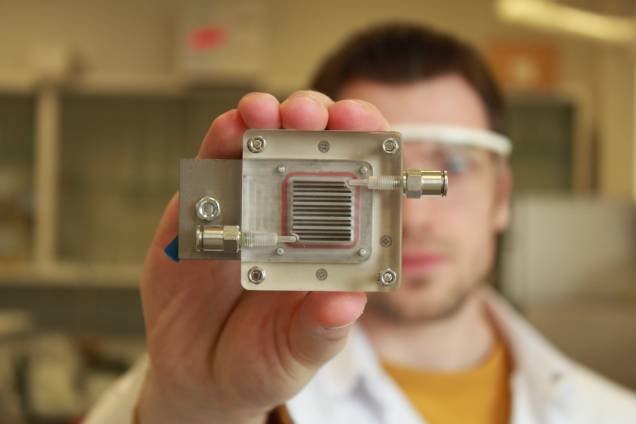
From Filthy Air To Fuel | Image: University of Antwerp
Researchers are developing a solar powered device that cleans up polluted air and in the process, creates a renewable fuel – hydrogen.
University of Antwerp and KU Leuven scientists say the underlying processes used are similar to those found in conventional solar panels.
The device uses a photoelectrochemical cell (PEC), a type of solar cell that generates either electricity or hydrogen using an action comparable to that used in the electrolysis of water. The researchers discovered these cells were even more efficient in generating hydrogen from polluted air.
The prototype device they’ve created has two chambers separated by a membrane composed of nanomaterials and is fully powered by light.
“Air is purified on one side, while on the other side hydrogen gas is produced from a part of the degradation products,” states Professor Sammy Verbruggen. Professor Verbruggen has a PhD in Bioscience Engineering and is currently working as a FWO postdoctoral fellow on the central theme of applying plasmonic photocatalysis in environmental and energy applications.
” This hydrogen gas can be stored and used later as fuel, as is already being done in some De Lijn hydrogen buses, for example. ”
The current operational device is very small, but the researchers are looking to build larger versions and ultimately, commercialising the invention.
” At a later stage, we would like to scale up our technology to make the process industrially applicable. We are also working on improving our materials so we can use sunlight more efficiently to trigger the reactions,” says Professor Verbruggen.
A paper on the device, Harvesting Hydrogen Gas from Air Pollutants with an Unbiased Gas Phase Photoelectrochemical Cell, has been published in the journal ChemSusChem.
While on the topic of hydrogen and membranes, we reported last week Australia could be shipping large quantities of hydrogen locked up in ammonia reasonably soon, thanks to technology being developed by CSIRO.
A key part of the tech is a reactor with a thin metal membrane that enables hydrogen to pass through during the ammonia decomposition process, while blocking all other gases.

 RSS - Posts
RSS - Posts



Speak Your Mind